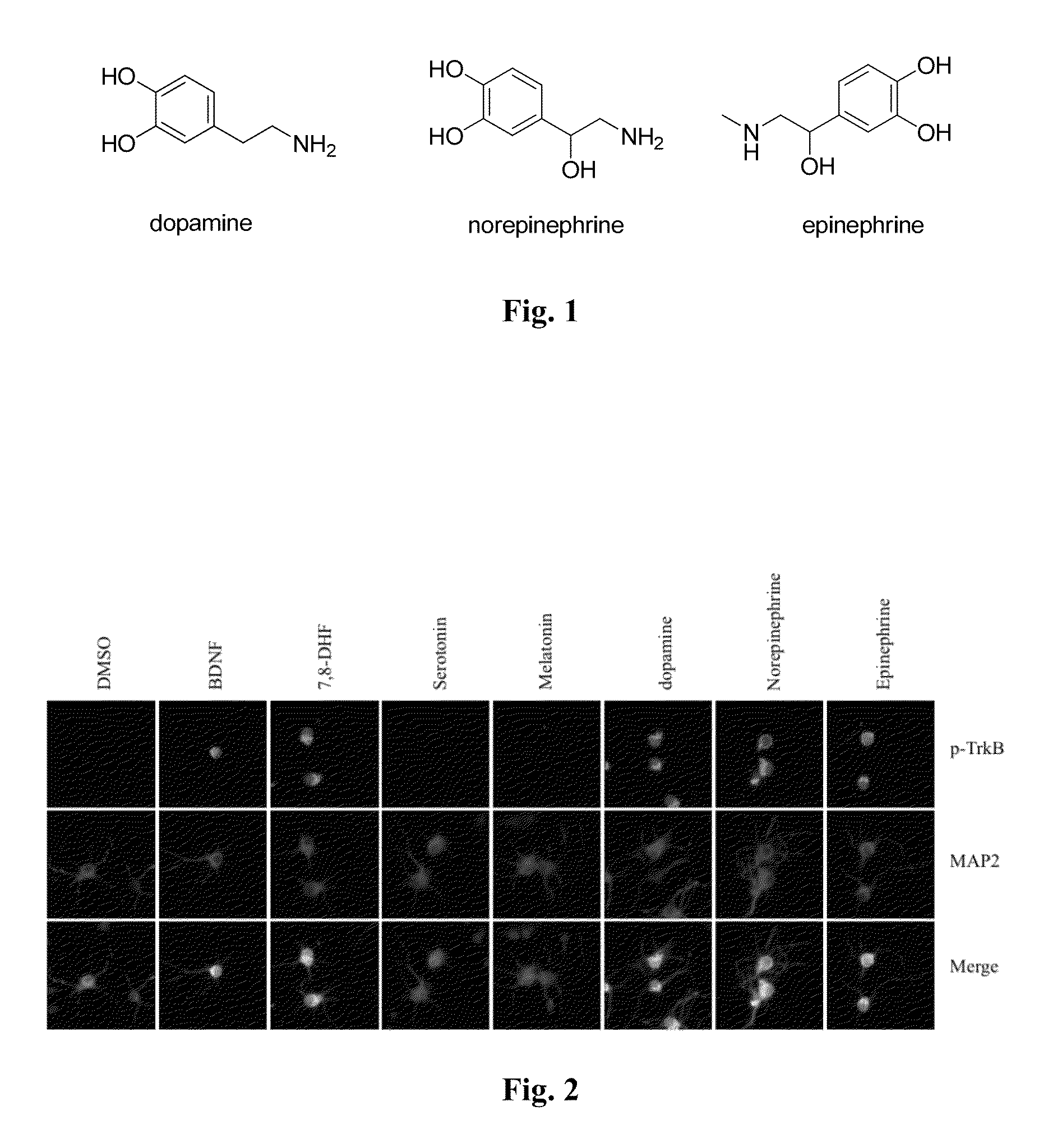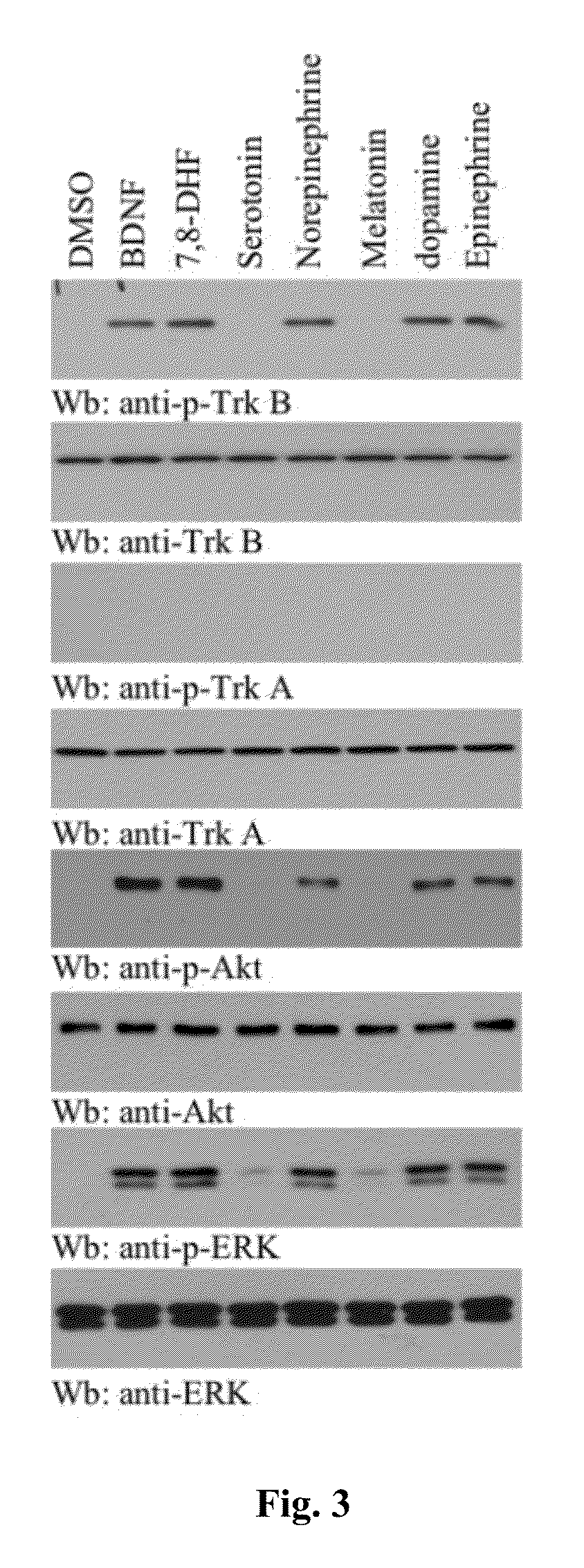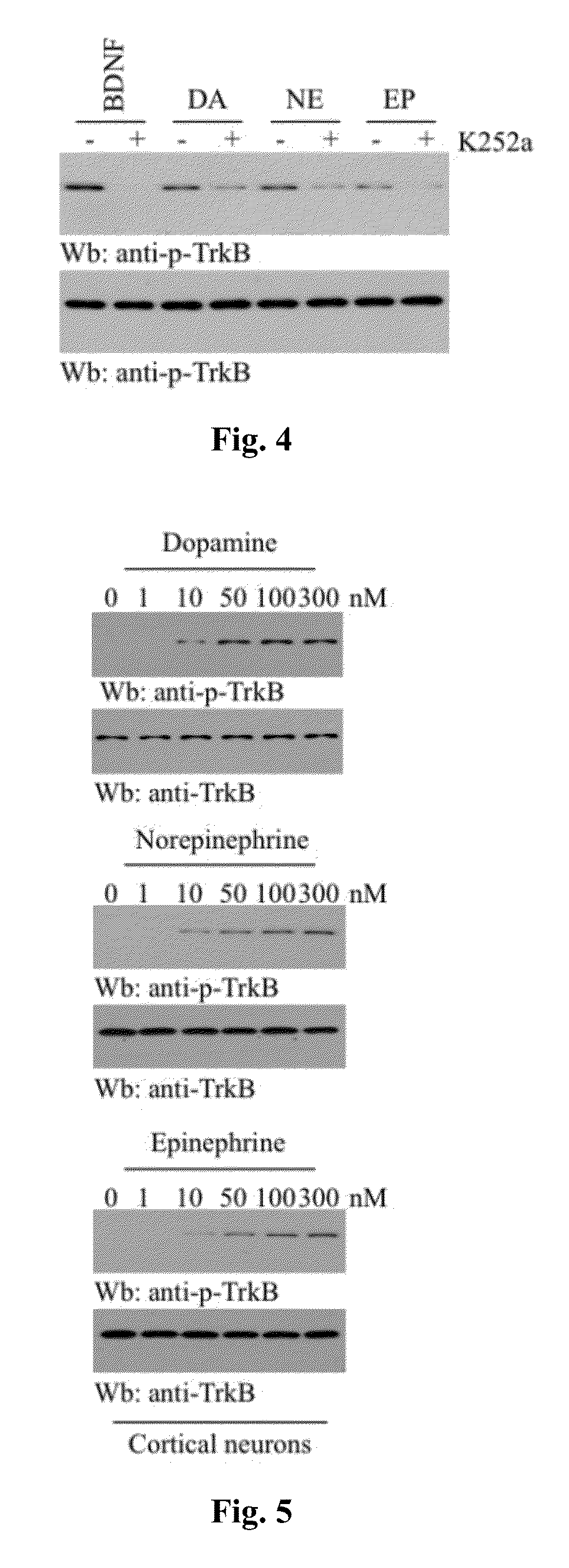Catecholamine derivatives for obesity and neurological disorders
a technology of catecholamine and derivatives, applied in the field of catecholamine derivatives for obesity and neurological disorders, can solve the problems of reducing energy affecting the neuroprotective effect of subjects, etc., and promoting neuroprotective
- Summary
- Abstract
- Description
- Claims
- Application Information
AI Technical Summary
Benefits of technology
Problems solved by technology
Method used
Image
Examples
example 1
Catecholamines Induce TrkB Activation in Primary Neurons in a Dose-dependent Manner
[0102]To explore whether monoamine neurotransmitters, including catecholamines (see, e.g., FIG. 1), could stimulate TrkB activation, hippocampal neurons were treated with 300 nM of catecholamines, serotonin, and melatonin for 30 min. Immunofluorescent staining with anti-phospho-TrkB Y816 showed that catecholamines, like BDNF, strongly triggered TrkB tyrosine phosphorylation, whereas serotonin and melatonin did not (FIG. 2). Other serotonin metabolites, including 5-HIAA (5-hydroxyindoleacetic acid) and 5-HT-sulfate, had no effect either. Immunoblotting analysis with the neuronal lysates revealed that TrkB, but not TrkA, was selectively activated by catecholamines. The analysis also showed that TrkB was not activated by serotonin or melatonin. The downstream signaling activation, including Akt and MAPK, correlates with TrkB phosphorylation (FIG. 3). K252a is a selective inhibitor of the tyrosine kinase ...
example 2
Catecholamines Directly Bind the Intracellular Domain of TrkB and Trigger its Dimerization
[0103]To determine whether catecholamines bind TrkB directly, an in vitro binding assay was conducted with purified ECD (extracellular domain) and ICD (intracellular domain) proteins from Trk receptors and 3H-catecholamines. The ICD, but not ECD, from the TrkB receptor bound to catecholamines. Epinephrine exhibited the strongest binding activity. By contrast, the counterparts of TrkA did not bind to 3H-catecholamines. As a positive control, 7,8-dihydroxyflavone selectively bound to the ECD of TrkB. Quantitative analysis by Scatchard plot revealed that the TrkB binding constants by dopamine, norepinephrine, and epinephrine were 76 μM, 98 μM, and 1.1 μM, respectively (FIGS. 7A& B). To determine whether the binding by catecholamines to TrkB receptor caused dimerization, GST-TrkB was co-transfected into HEK293 cells with HA-TrkB, followed by BDNF or monoamines treatment for 15 minutes. Co-immunopre...
example 3
Catecholamines Specifically Activate TrkB in Neurotrophins Independent Manner
[0105]Both antidepressants and exercise increase hippocampal BDNF mRNA expression through enhanced 5-HT and / or NE neurotransmission (Siuciak et al., Pharmacol. Biochem. Behav., 56:131-137, 1997; Dias et al., Neuropharmacology, 45:553-563, 2003; Ivy et al., Pharmacol. Biochem. Behav., 75:81-88, 2003; Garza et al., Pharmacol. Biochem. Behav., 77:209-220, 2004). If catecholamines activated TrkB signaling indirectly by promoting BDNF generation, then scavenging BDNF with its specific antibody would be expected to diminish catecholamines-mediated activation of TrkB. Cultured cortical neurons were pretreated with BDNF-IgG for 30 minutes followed by exposure to BDNF (10 ng / ml) or catecholamines (100 nM) for 15 minutes. Pretreatment with BDNF-IgG abolished BDNF-induced phosphorylation of TrkB; by contrast, BDNF-IgG had no effect on 7,8-dihydroxyflavone or catecholamine-induced phosphorylation of TrkB (FIG. 10), sug...
PUM
| Property | Measurement | Unit |
|---|---|---|
| pH | aaaaa | aaaaa |
| concentration | aaaaa | aaaaa |
| concentration | aaaaa | aaaaa |
Abstract
Description
Claims
Application Information
 Login to View More
Login to View More - R&D
- Intellectual Property
- Life Sciences
- Materials
- Tech Scout
- Unparalleled Data Quality
- Higher Quality Content
- 60% Fewer Hallucinations
Browse by: Latest US Patents, China's latest patents, Technical Efficacy Thesaurus, Application Domain, Technology Topic, Popular Technical Reports.
© 2025 PatSnap. All rights reserved.Legal|Privacy policy|Modern Slavery Act Transparency Statement|Sitemap|About US| Contact US: help@patsnap.com



